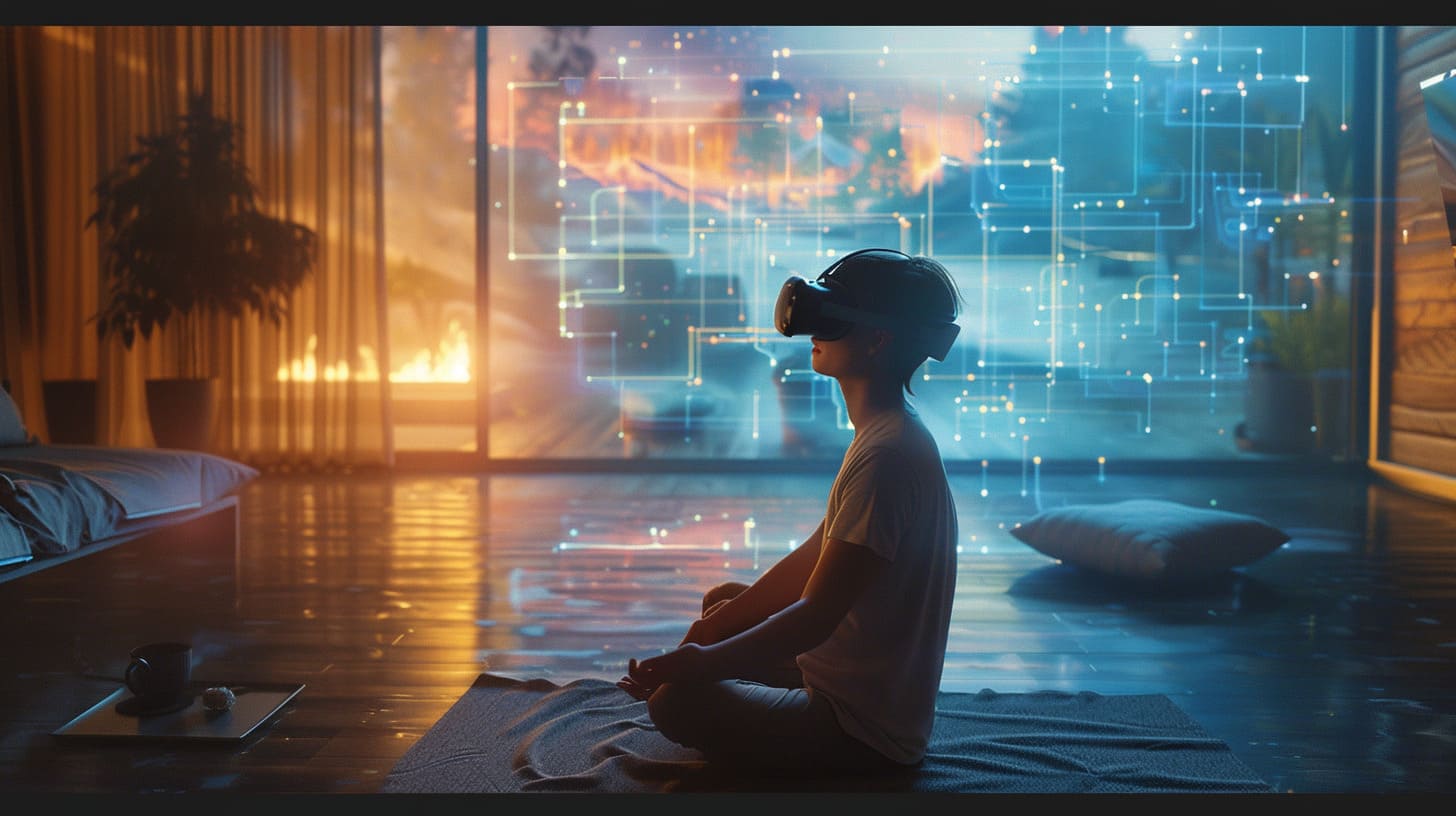Desired reality, a concept deeply rooted in the latest psychological theories, is essentially your personal utopia. It’s that version of your life where everything aligns with your deepest wishes and aspirations. Far from being a mere daydream, shaping your desired reality is a pivotal aspect of personal development. Why? Because it empowers you to transform your life from what it is now to what you want it to be, using positive psychology, cognitive-behavioral therapy, and mindfulness practices.
Understanding desired reality begins with grasping the power of constructive thinking. This approach encourages you to focus on the positives, reframe negatives, and practice gratitude. It’s about altering your mindset to view your life through a lens of optimism and opportunity. Imagine the difference it could make if, instead of dwelling on setbacks, you viewed them as stepping stones to your goals.
Mental contrasting, another key technique, asks you to vividly compare your current life with the one you desire. This isn’t about indulging in wishful thinking but identifying the practical steps you can take to bridge the gap between these two realities. It’s a strategy that motivates action, turning daydreams into achievable objectives.
Then there’s the concept of flow, a state where you’re so immersed in an activity that everything else fades away. Achieving flow is about finding joy and fulfillment in the present, making it a crucial ingredient in the creation of your desired reality. It’s about identifying and pursuing activities that ignite this passion and focus, thereby enriching your daily life.
In recent years, the conversation around desired reality has shifted significantly. Gone are the days when it was dismissed as mere fantasy. Today, it’s recognized as a powerful tool for personal growth. This evolution in thought underscores the importance of mindset and perception. After all, perceiving your reality through a positive lens can dramatically enhance your well-being.
Frequently Asked Questions:
1. How to create a desired reality?
2. Desired reality vs. reality: what’s the difference?
3. Techniques for creating a desired reality
Each question reflects a common inquiry aimed at unlocking the secrets to personal transformation. Whether it’s through visualization, meditation, or altering one’s mindset, the journey toward your desired reality is paved with strategies that tap into the psychological and metaphysical aspects of personal development.
Key Techniques for Personal Transformation:
- Positive Thinking: Cultivate an optimistic outlook.
- Goal-Setting: Define clear, achievable goals.
- Mindfulness: Practice being present and aware.
- Visualization: Employ vivid imagery to envision your desired reality.
- Meditation: Use meditation to clear the mind and focus on your goals.
By embracing these techniques, you embark on a transformative journey. It’s a path that leads not just to a better understanding of yourself but to the very realization of your dreams and desires. So, let’s dive deeper into the world of desired reality and explore how you can make your ideal life your actual life.
The Science Behind Desired Reality

Imagine your brain as a dynamic landscape, constantly reshaped by your thoughts, experiences, and practices. This is the essence of neuroplasticity. It’s the science behind why and how you can alter your perception of reality, simply by engaging in certain mental exercises. Neuroplasticity demonstrates that your brain isn’t fixed but rather is highly adaptable, continuously evolving in response to your environment and inner world.
Recent studies have shed light on how practices like mindfulness meditation can significantly influence this adaptability. For instance, engaging in long-term meditation has been shown to enhance connectivity in the brain’s default mode network (DMN), which plays a crucial role in how you process self-referential thoughts and introspection. This change suggests a profound impact on your perception, potentially altering your experienced reality.
Another compelling example comes from research involving individuals with amblyopia, commonly known as lazy eye. Intensive visual training not only improved their vision but also led to observable changes in the brain’s visual processing areas. This demonstrates that with targeted training, it’s possible to reshape the way your brain interprets and processes sensory information.
Practical Application of Neuroplasticity
Let’s break down some specific practices that can leverage neuroplasticity to shift your reality:
1. Mindfulness Meditation: Enhances brain areas related to attention, emotion regulation, and self-awareness.
2. Cognitive Behavioral Therapy (CBT): Alters brain activity and connectivity by changing negative thought patterns.
3. Neurofeedback: Trains the brain to produce specific electrical activity patterns, improving conditions like ADHD and anxiety.
4. Mental Imagery Training: Visualizing specific outcomes can alter brain activity, boosting performance in sports and academics.
The evolution of our understanding of neuroplasticity has paved the way for new methods to harness this brain adaptability. Techniques such as non-invasive brain stimulation and immersive technologies like virtual reality offer novel ways to induce neuroplastic changes, effectively allowing you to alter your perceived reality through intentional mental practices.
In essence, the science of neuroplasticity empowers you with the knowledge that you have the capability to rewire your brain. By incorporating targeted practices into your routine, you can gradually shift your mindset and, consequently, your reality. Whether it’s through mindfulness, visualization, or other transformation practices, the potential for personal development and altering your perception lies within the grasp of your mind’s incredible flexibility.
Role of Virtual and Augmented Realities

Imagine stepping into a world where your desired realities are within arm’s reach, and you can practice becoming your ideal self in environments that feel as real as the world outside. This isn’t just a pipe dream; it’s the promise of Virtual Reality (VR) and Augmented Reality (AR). These technologies are rapidly transforming the landscape of personal development, offering tools that can profoundly alter our experiences and perceptions.
The Cutting Edge of VR and AR
Wireless VR headsets are breaking the physical chains that once tethered us to bulky computers, granting the freedom to move and explore virtual spaces as you would the real world. This leap in technology means activities aimed at personal growth, like meditation or fitness programs, have become more immersive and accessible than ever before.
Eye-tracking technology fine-tunes your virtual experience, adjusting visuals in real-time based on where you’re looking. This not only enhances immersion but significantly reduces the discomfort of motion sickness, making prolonged sessions in VR more comfortable and appealing.
Haptic feedback, the technology that simulates touch, adds a layer of realism to VR and AR by allowing you to ‘feel’ virtual objects. Whether it’s the resistance of a bowstring in a meditation game or the texture of a fabric in a fashion app, haptic feedback deepens the connection between you and your digital environment.
Social VR platforms offer a new dimension of interaction, enabling you to meet and engage with others in virtual spaces. This can be a game-changer for those looking to improve social skills, offering a safe and controlled environment to practice and learn.
Finally, AR’s role in mental health is burgeoning, with apps designed to overlay calming visuals or helpful guides onto our everyday surroundings, offering support and techniques to manage anxiety and stress wherever you are.
The Impact on Users
- VR Therapy: This innovative approach has proven effective in treating conditions such as anxiety disorders and PTSD, offering immersive experiences that help patients confront and work through their fears in a controlled setting.
- VR Training: From aerospace to automotive, industries are turning to VR to provide employees with realistic, engaging training experiences that improve retention and performance without the risks associated with real-life training.
- AR Education: AR is revolutionizing the educational landscape, allowing students to interact with complex concepts in three dimensions, thereby enhancing understanding and engagement.
Navigating Ethical and Psychological Terrain
With great power comes great responsibility. The allure of VR and AR is undeniable, but it’s crucial to consider the potential pitfalls. Addiction, privacy concerns, social isolation, and the risk of exacerbating mental health issues are real concerns that need addressing. Users and developers alike must tread carefully, ensuring that these technologies are used to enrich lives, not escape them.
The psychological effects of VR and AR — from the immersion and presence they offer to the anxiety or depersonalization they may cause — are a double-edged sword. Understanding and mitigating these impacts is key to harnessing the full potential of VR and AR in personal development.
In conclusion, VR and AR are redefining the boundaries of our reality, offering unprecedented opportunities for personal growth and transformation. By embracing these technologies with awareness and care, we stand on the brink of a new era in personal development, where our desired realities are not just imagined but experienced.
Mindfulness and Meditation Techniques for Reality Shifting
Recent scientific studies indicate that mindfulness and meditation can significantly impact our perception of reality and mental state. For instance, mindfulness meditation can lead to alterations in the brain’s default mode network (DMN), correlating with enhanced reality perception and a decrease in delusional beliefs. This suggests that engaging in mindfulness can help in reshaping our reality by adjusting how we process thoughts and emotions.
Moreover, mindfulness meditation boosts the sense of control over one’s actions and their outcomes, enhancing the ability to shift realities by making individuals feel more in control of their perceptions. Changes in how we perceive time, space, and self are also reported, including altered perceptions of objects and a heightened sense of interconnectedness, which are crucial for successful reality shifting.
Mindfulness and meditation assist in reality shifting by enhancing awareness of thoughts and perceptions, improving focus and concentration, and regulating emotions. These aspects are vital in maintaining a clear intention and managing any stress or anxiety during the process.
Effective Mindfulness and Meditation Practices
There are several practical exercises to embark on this journey:
- Mindfulness Meditation: Focus on the present moment, using a mantra or breath sensation.
- Loving-kindness Meditation: Cultivate a sense of compassion towards oneself and others.
- Body Scan Meditation: Sequentially bring awareness to different body parts.
- Visualization Meditation: Mentally visualize desired outcomes or experiences.
The use of technology, such as apps and virtual reality, has become increasingly popular in enhancing these practices. These tools offer guided meditations and resources to support individuals in developing a consistent meditation practice, potentially facilitating the desired reality shifting.
By incorporating these mindfulness and meditation techniques into your daily routine, you embark on a transformative journey towards altering your mental state and perceptions, enabling a shift into your desired reality. Embrace these practices with an open heart and mind for a profound personal development and reality transformation experience.
Real-life Applications and Case Studies
The power of desired reality shifting isn’t just a concept; it’s being applied actively across various sectors such as business, education, and personal growth, transforming how we interact, learn, and overcome personal challenges.
Shifting Realities in Business
In the business world, the embrace of virtual and augmented realities has revolutionized traditional practices. Take, for instance, the COVID-19 pandemic’s impact, which propelled companies like Facebook and Walmart to adopt virtual platforms for events and training. Facebook’s F8 developer conference utilized Oculus to create an immersive virtual event, breaking the mold of conventional conferences. Similarly, Walmart and Microsoft have leveraged virtual training programs to enhance employee learning, leading to increased retention and engagement.
Moreover, marketing has seen a paradigm shift with brands like Gucci launching virtual stores on platforms like Roblox. This not only captivated a younger audience but also showcased how brands can extend their reach beyond physical boundaries, creating a desired reality where digital interactions become as valuable as physical ones.
Educational Transformations
The field of education has witnessed a significant transformation with the integration of VR and AR technologies, providing students with immersive learning experiences. The University of Maryland, Baltimore County, for example, introduced a VR program that allows detailed exploration of the human body in 3D. This hands-on approach to learning has proven to be more engaging and effective than traditional methods.
Art and installation exhibits have also incorporated AR to create interactive experiences, such as the “JR: Chronicles” at Palais de Tokyo, Paris. Here, AR technology invites visitors into an immersive journey through the artist’s works, enhancing the viewer’s engagement and understanding.
Personal and Professional Growth through Reality Shifting
On a personal level, desired reality shifting techniques have shown remarkable success in overcoming fears and enhancing mental health. Erik Davis’s story of conquering his fear of heights through gradual exposure to virtual environments demonstrates how VR can be a
powerful tool for psychological transformation. Likewise, the advent of VR-based therapy apps like Wave VR signifies a breakthrough in mental health care, offering immersive sessions that are accessible regardless of physical limitations.
Furthermore, language learning has seen innovative advancements with VR applications, proving to be effective in improving vocabulary and comprehension. This not only aids in personal development but also opens up new professional opportunities for learners.
Key Takeaways
- Business Innovation: Virtual events and training programs are redefining traditional business practices, enhancing engagement and learning.
- Educational Advancement: VR and AR technologies in education offer immersive, effective learning experiences beyond conventional methods.
- Personal Growth: VR therapy and immersive learning tools provide innovative solutions for overcoming fears, treating mental health issues, and acquiring new skills.
Desired reality shifting techniques are not just theoretical concepts but practical tools that have been successfully integrated across various sectors, demonstrating the vast potential of altering our perceptions to enhance business practices, education, and personal development. Whether it’s through immersive virtual events, interactive learning environments, or therapeutic
applications, these techniques are paving the way for significant transformations in how we perceive and interact with the world around us.
Conclusion
Throughout this exploration of desired reality shifting techniques, we’ve uncovered the profound impact these practices can have on personal development. From the anecdotal success stories to the solid backing of scientific research, it’s clear that techniques such as lucid dreaming, visualization, affirmations, and mindfulness meditation offer tangible benefits. These range from improved mental health to enhanced motor skills, demonstrating the significant role our mindset and subconscious mind play in shaping our reality.
The concept of neuroplasticity has provided a scientific foundation for these practices, affirming that our brains are indeed capable of restructuring and adapting in response to our thoughts, emotions, and experiences. This understanding opens up endless possibilities for personal transformation and development, empowering you to actively participate in the creation of your desired reality.
To further your journey into reality shifting, consider diving into resources such as books like “The Power of Now,” “The Secret,” and “The Power of Visualization.” Websites and interactive platforms offer a wealth of knowledge and community support to guide you in these practices. Remember, the key to success lies in consistency and belief in the process.
In summary, reality shifting techniques offer a powerful toolkit for personal growth and well-being. By harnessing the power of the mind, you can alter your perception of reality, leading to meaningful changes in your life. Embrace these practices with an open heart and mind, and witness the transformation within yourself and your surroundings.

Leave a Reply